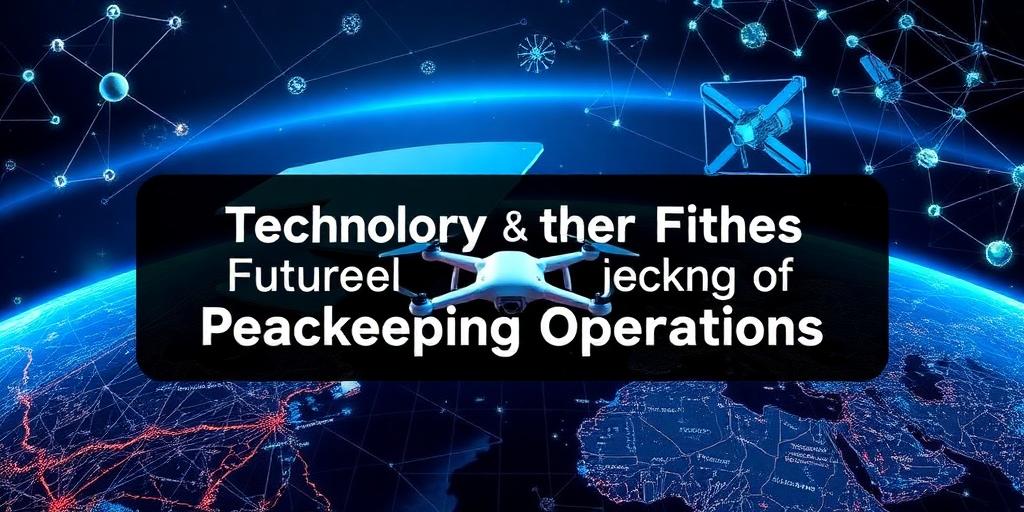Technology and the Future of Peacekeeping Operations
Peacekeeping operations have evolved significantly over the decades, adapting to increasingly complex and volatile global landscapes. Today, technology is at the forefront of this evolution, offering unprecedented opportunities to enhance the effectiveness, efficiency, and safety of peacekeeping missions. This post explores how technology is shaping the future of peacekeeping, examining current applications and potential future advancements.
Current Technological Applications in Peacekeeping
Several key technologies are already transforming peacekeeping operations:
- Unmanned Aerial Vehicles (UAVs): Drones provide real-time aerial surveillance, monitor conflict zones, and gather critical intelligence without risking human lives. They can also deliver essential supplies to remote locations.
- Satellite Communications: Reliable communication is crucial for coordinating peacekeeping efforts. Satellite technology ensures secure and uninterrupted communication lines between field operations and headquarters, even in areas with damaged infrastructure.
- Data Analytics and AI: Advanced data analytics tools and artificial intelligence (AI) algorithms can process vast amounts of information to predict potential conflicts, identify patterns of violence, and assist in decision-making processes.
- Biometrics: Biometric technologies, such as facial recognition and fingerprint scanning, are used to verify identities, manage refugee camps, and prevent the entry of armed groups into protected areas.
- Geographic Information Systems (GIS): GIS technology provides detailed mapping and spatial analysis capabilities, helping peacekeepers understand the terrain, plan operations, and manage resources effectively.
The Impact of Technology on Peacekeeping Effectiveness
Technology enhances peacekeeping operations in several ways:
- Improved Situational Awareness: Real-time data collection and analysis provide peacekeepers with a comprehensive understanding of the operational environment, enabling them to respond quickly and effectively to emerging threats.
- Enhanced Protection of Civilians: UAVs and surveillance technologies help monitor vulnerable populations, detect potential attacks, and provide early warnings, allowing peacekeepers to intervene proactively.
- Increased Efficiency: Automation and data-driven decision-making streamline logistical operations, reduce response times, and optimize resource allocation, making peacekeeping missions more efficient and cost-effective.
- Reduced Risk to Peacekeepers: Remote sensing technologies and unmanned systems minimize the need for human presence in dangerous areas, reducing the risk of casualties and improving the safety of peacekeeping personnel.
Challenges and Considerations
Despite the numerous benefits, integrating technology into peacekeeping operations also presents challenges:
- Data Security and Privacy: The collection and use of sensitive data raise concerns about privacy and security. Robust data protection measures and ethical guidelines are necessary to prevent misuse and ensure compliance with international human rights standards.
- Technological Dependence: Over-reliance on technology can create vulnerabilities. Peacekeepers must maintain traditional skills and strategies to operate effectively in situations where technology fails or is unavailable.
- Cost and Accessibility: Advanced technologies can be expensive, limiting their accessibility to resource-constrained peacekeeping missions. International cooperation and resource-sharing mechanisms are needed to bridge this gap.
- Training and Capacity Building: Effective use of technology requires adequate training and capacity building. Peacekeepers must be equipped with the skills and knowledge to operate and maintain advanced systems.
The Future of Peacekeeping Technology
Looking ahead, several emerging technologies hold promise for further transforming peacekeeping operations:
- Artificial Intelligence and Machine Learning: AI can automate routine tasks, analyze complex data sets, and provide predictive analytics to anticipate and prevent conflicts. Machine learning algorithms can improve the accuracy and reliability of decision-making processes.
- Virtual and Augmented Reality: VR and AR technologies can enhance training simulations, allowing peacekeepers to practice responding to various scenarios in a safe and realistic environment. They can also provide real-time information and guidance during field operations.
- Blockchain Technology: Blockchain can enhance transparency and accountability in peacekeeping operations by providing a secure and tamper-proof record of transactions and activities. It can also facilitate the distribution of aid and resources in a transparent and efficient manner.
- Internet of Things (IoT): IoT devices can monitor environmental conditions, track the movement of people and goods, and provide early warnings of potential threats. They can also enhance communication and coordination among peacekeeping personnel.
Conclusion
Technology is revolutionizing peacekeeping operations, offering unprecedented opportunities to enhance effectiveness, efficiency, and safety. By leveraging advanced tools and strategies, peacekeepers can better protect civilians, prevent conflicts, and promote sustainable peace. However, it is crucial to address the challenges and considerations associated with technology integration, ensuring that it is used responsibly and ethically. As technology continues to evolve, peacekeeping operations must adapt and innovate to remain effective in an increasingly complex and interconnected world. Embracing these advancements while mitigating potential risks will pave the way for a future where technology plays a central role in achieving and sustaining global peace.
Long-Tail Keywords
- Technology in UN peacekeeping
- AI in conflict resolution
- Drones for peace monitoring
- Satellite tech for peacekeeping missions
- Future of peacekeeping tech









